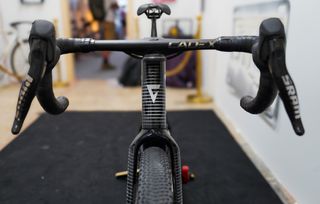Unbound Gravel was a hotspot for unreleased new bike tech this year. We spotted SRAM’s unreleased 13-speed Red XPLR AXS groupset, a COROS bike computer with 90+ hours of battery life, new niche race kit and new wheels.
We also got glimpses of new bikes, including a prototype Giant, which we are pretty sure is a new top-end Revolt.
This bike was raced by Australian Brendan Johnston, a.k.a Trekky, of the Giant Factory Team in the men’s elite 200-mile event. Johnston finished in 15th place after an impressive performance in a “cruel” race that saw him suffer three flat tyres.

(Image credit: Anne-Marije Rook)
Giant remains mum on the details of the new bike, but here’s what we know:
Giant introduced the Revolt gravel bike a decade ago, and several iterations have since been released, addressing the need for ever-more capable and faster off-terrain steeds.
The range’s flagship model, the Revolt Advanced Pro, has pushed the boundaries of weight while striking a balance of compliance and capabilities with speed and race geometries.
Innovations over the past few iterations include:
The latest race content, interviews, features, reviews and expert buying guides, direct to your inbox!
– A flip chip rear dropout to allow riders to adjust the wheelbase to fine-tune the handling for different types of terrain.
– The lowering of seatstay junctions with thinner-diameter tubes to improve rear-end compliance.
– The brand’s proprietary D-Fuse seatpost aimed at reducing shocks and vibrations from the rough surface.
Many of these technologies appear to be present in this prototype as well.
At first glance, the biggest change is the addition of downtube storage—an increasing trend in gravel bikes and something that riders, rather than racers, have been asking for, Giant revealed.
Incorporating storage into the downtube involves more than simply cutting a hole in the carbon. There are complex design elements to consider, including devising an access door or cover, hinges and latches, ensuring that the compartment and the contents don’t interfere with the internal cable routing, and, of course, the structural integrity of the downtube. To compensate for the cutout, manufacturers must add extra material, meaning that this new prototype may not be any lighter or even as light as its predecessors.

(Image credit: Anne-Marije Rook)
New also is the internal frame routing. Internal routing isn’t the easiest for home mechanics to work on, but it does create clean—perhaps even more aerodynamic—lines and allows riders to attach accessories without the interference of cables.
The D-Fuse seatpost and flip-chip are present on this prototype as well, but notably missing is the addition of a UDH interface. Introduced by SRAM in 2019, the Universal Derailleur Hanger (UDH) standardizes the derailleur mounting interface across different bike frames, aimed at improving shifting performance and increasing the system’s robustness.

(Image credit: Anne-Marije Rook)
A UDH interface is required to run the new 13-speed SRAM Red XPLR AXS derailleur we spotted, which Trekky, while being an SRAM-sponsored athlete, could not make use of. While he did use the new SRAM red brake-shift levers, carried over from the newly released SRAM Red road groupset, Trekky has to make do with a SRAM mullet build consisting of a 1x chaining in the front and a 12-speed mountain bike transmission derailleur and Eagle cassette in the rear. Whether this bike, once commercially available, will feature a UDH interface is as of yet unknown.

The new SRAM Red brake-shift levers
(Image credit: Anne-Marije Rook)
The cockpit on Trekky’s bike appears to be CADEX’s Aero Integrated Handlebar, a $699 upgrade that we’re guessing will not be standard issue on the commercially available bikes or perhaps on the very top-end models only.
For his course recon rides, Trekky was running CADEX AR 35 Disc Tubeless gravel wheels with carbon spokes and wrapped in 50mm Pirelli Cinturato tyres with ample clearance left.

(Image credit: Anne-Marije Rook)
As with the current model, the prototype sports accessory mounts on the toptube and downtube.
Again, Giant would not reveal anything about this other than what our own eyes could see but we’re certain it will be released later this season. Stay tuned.

(Image credit: Anne-Marije Rook)

